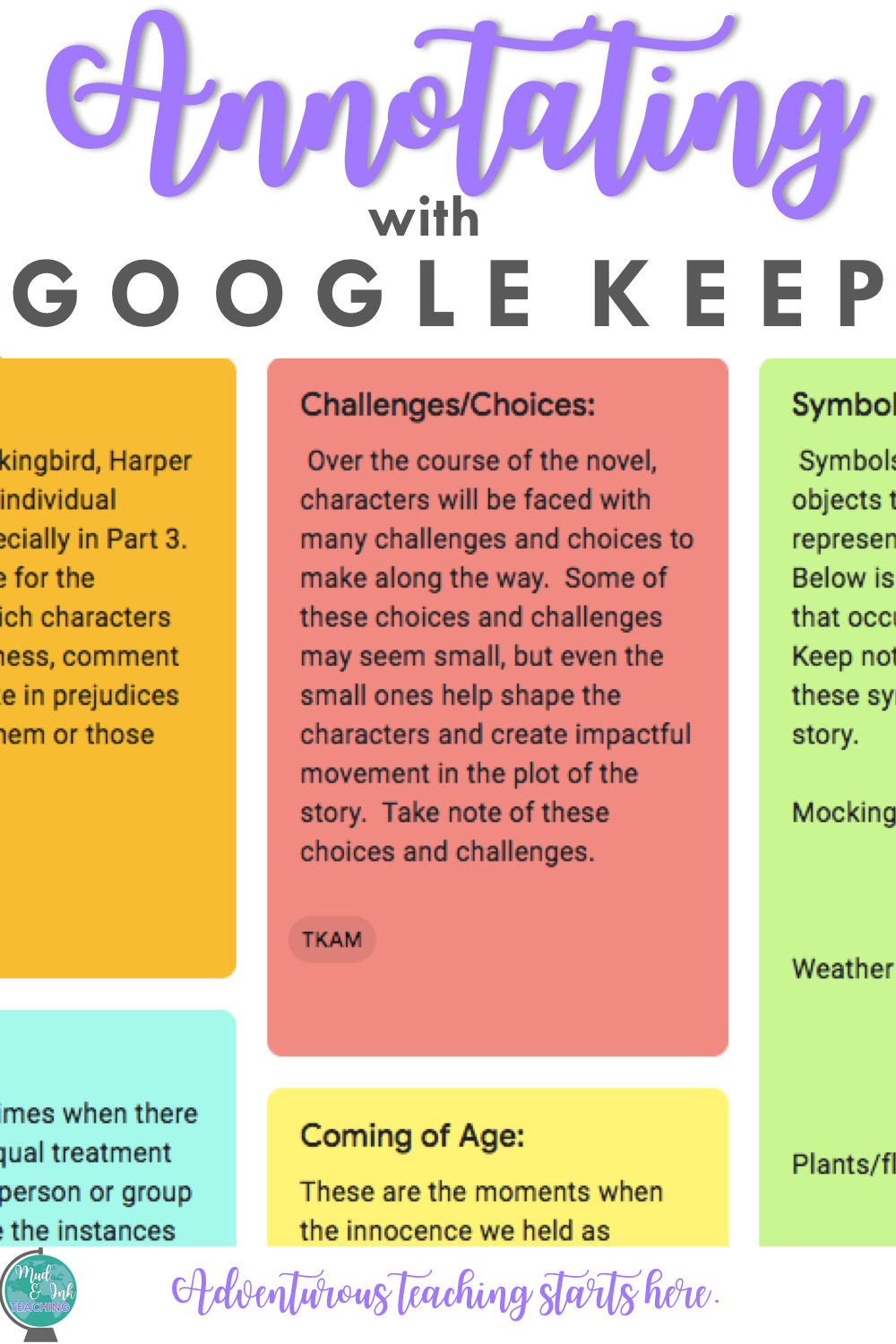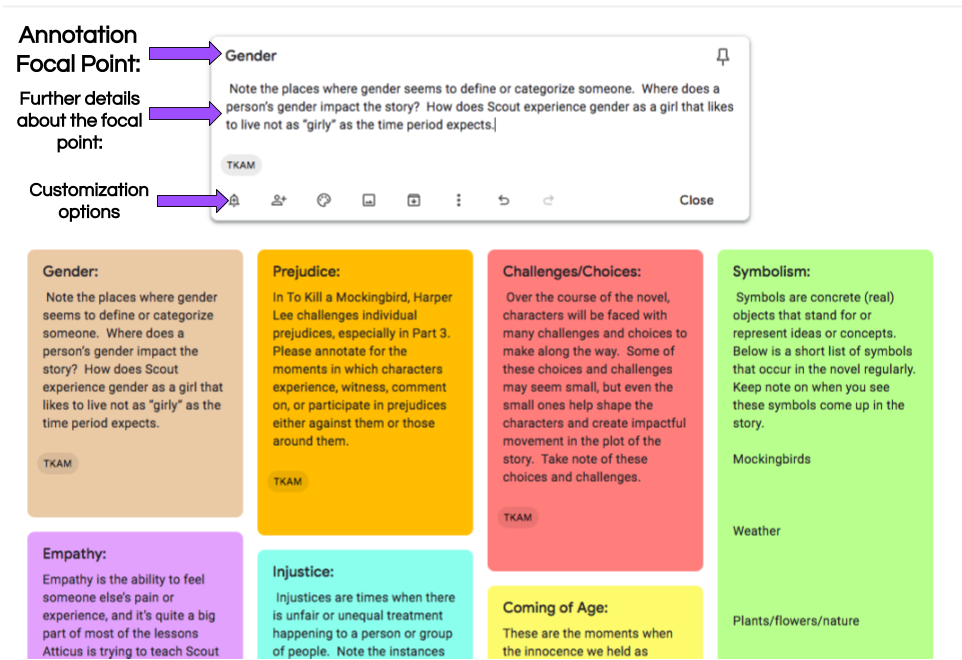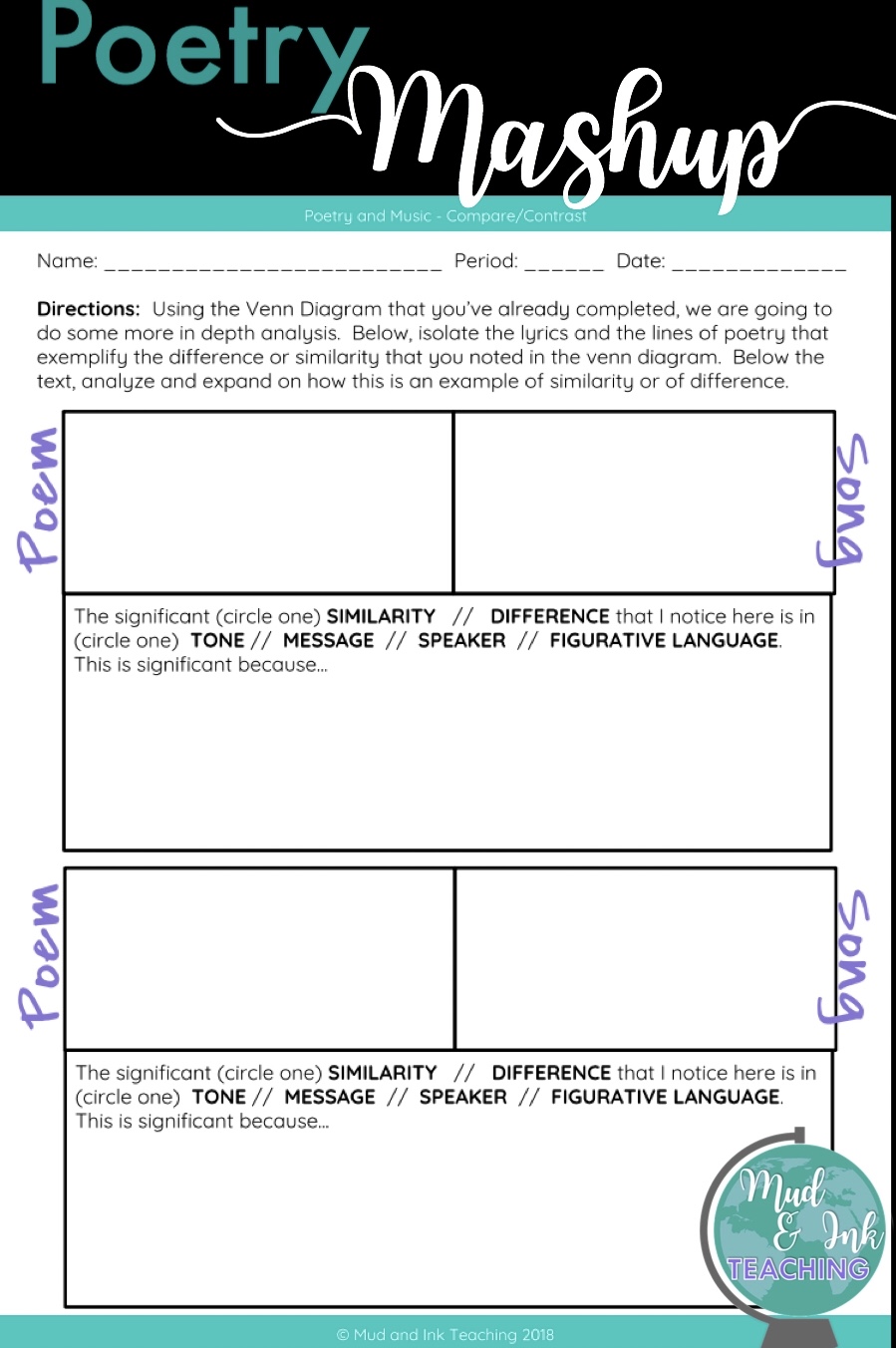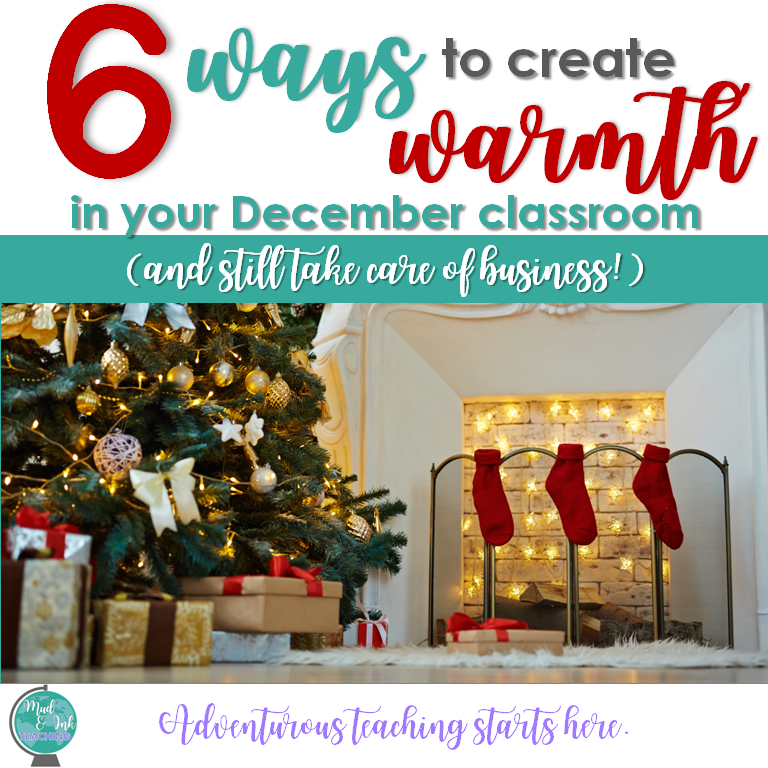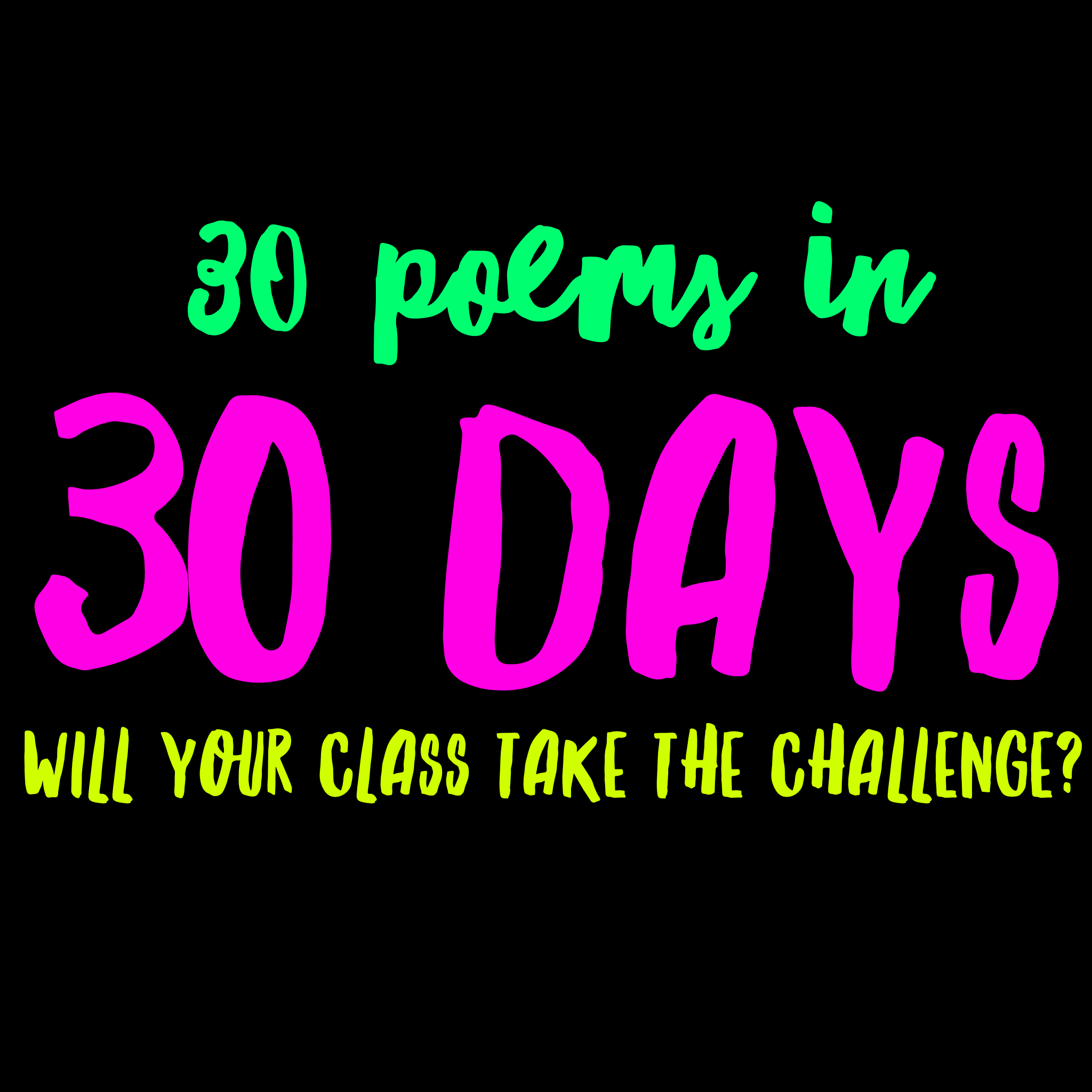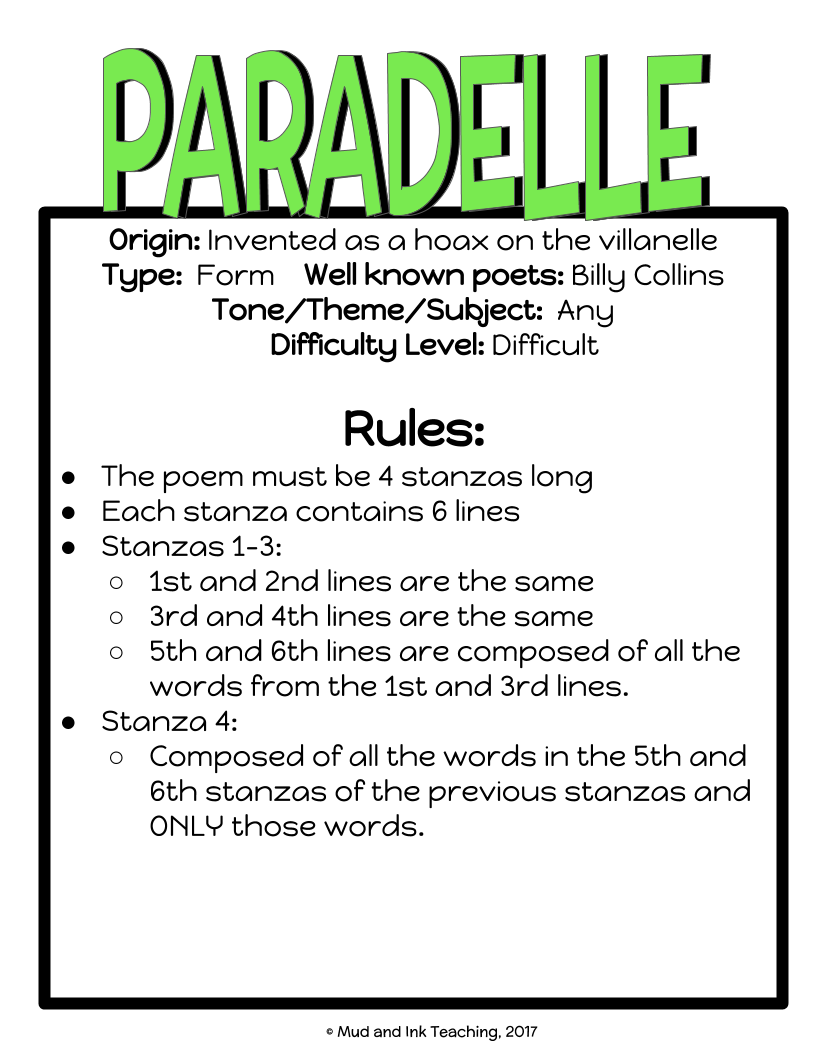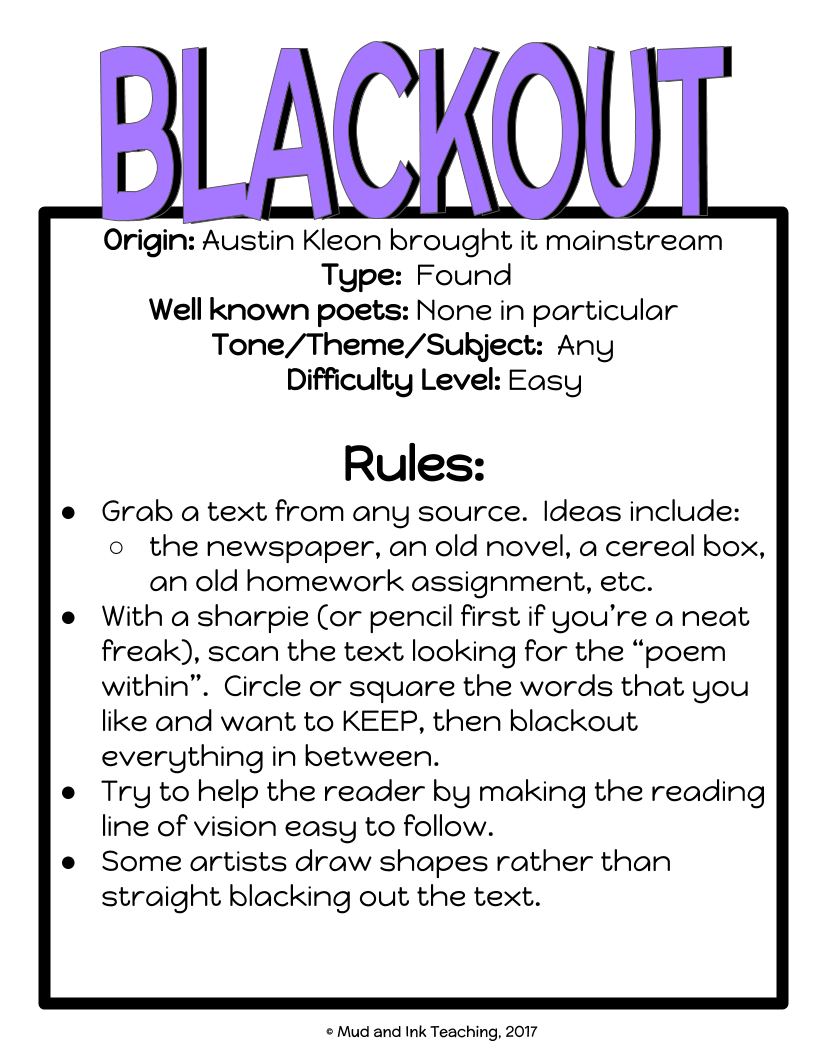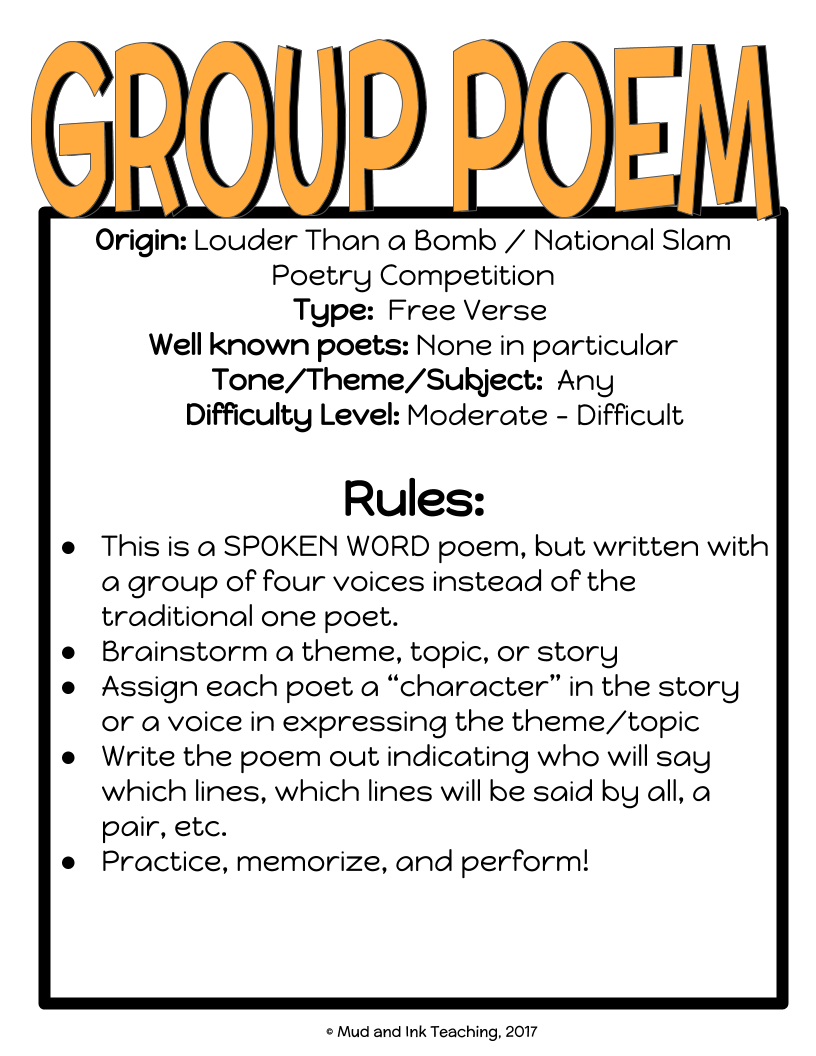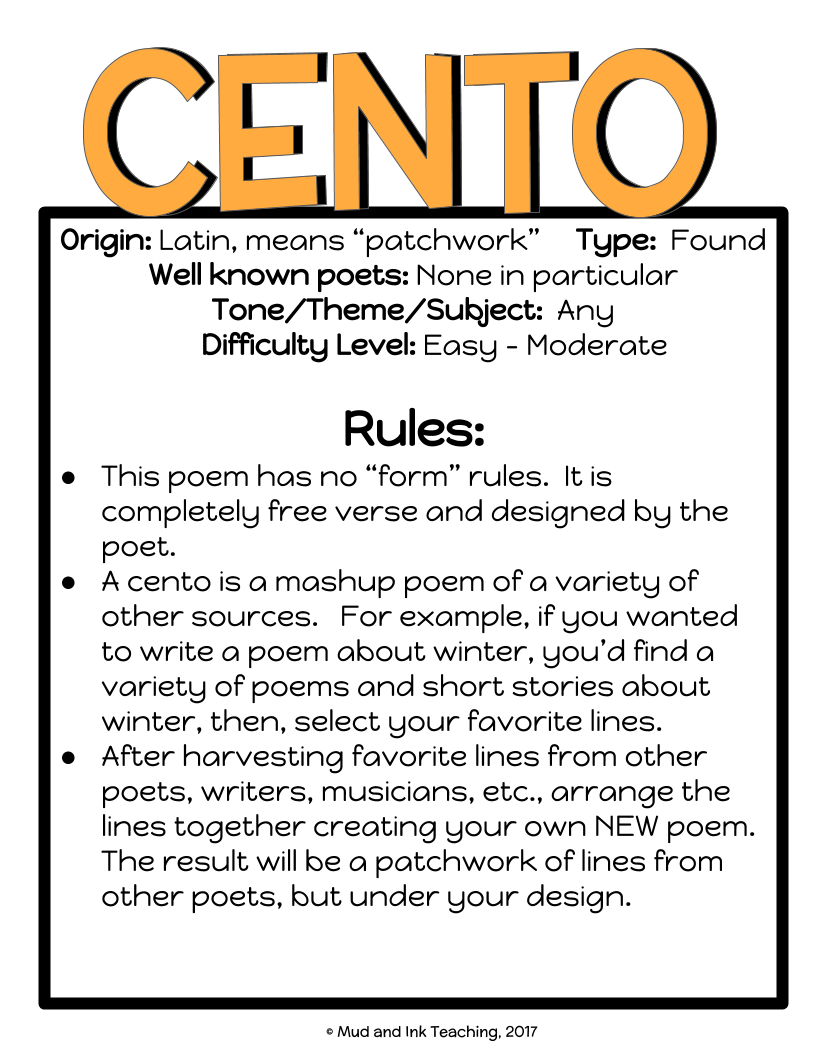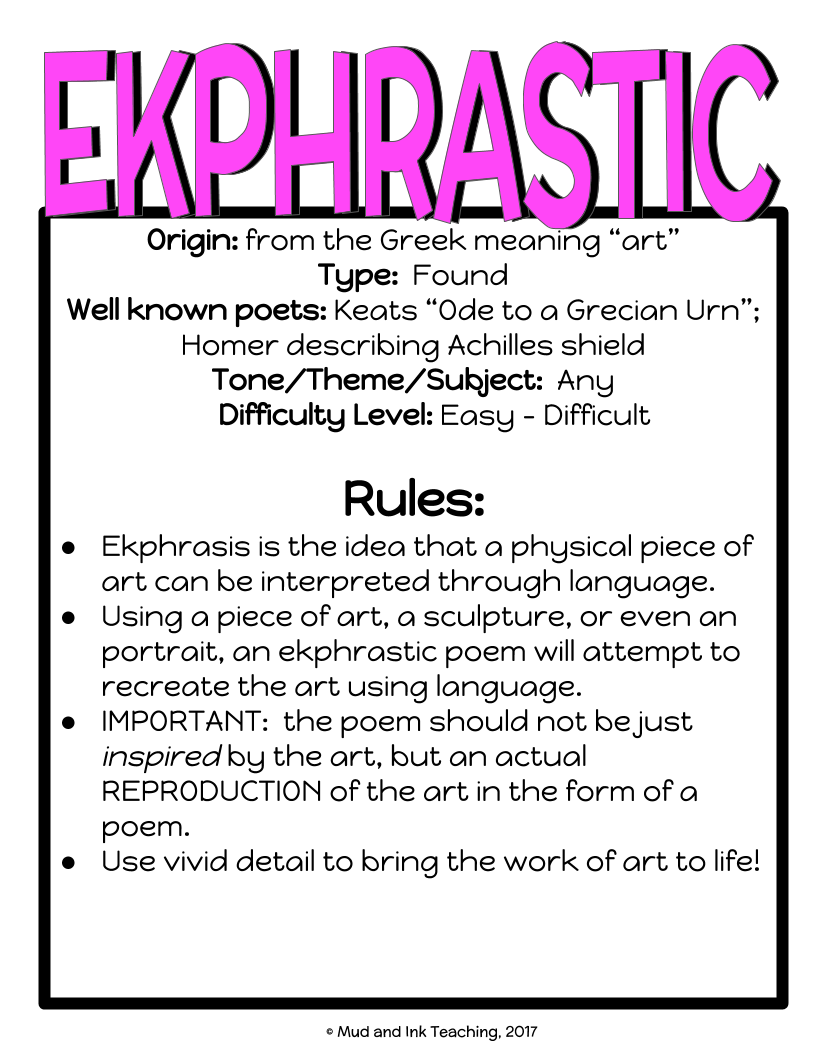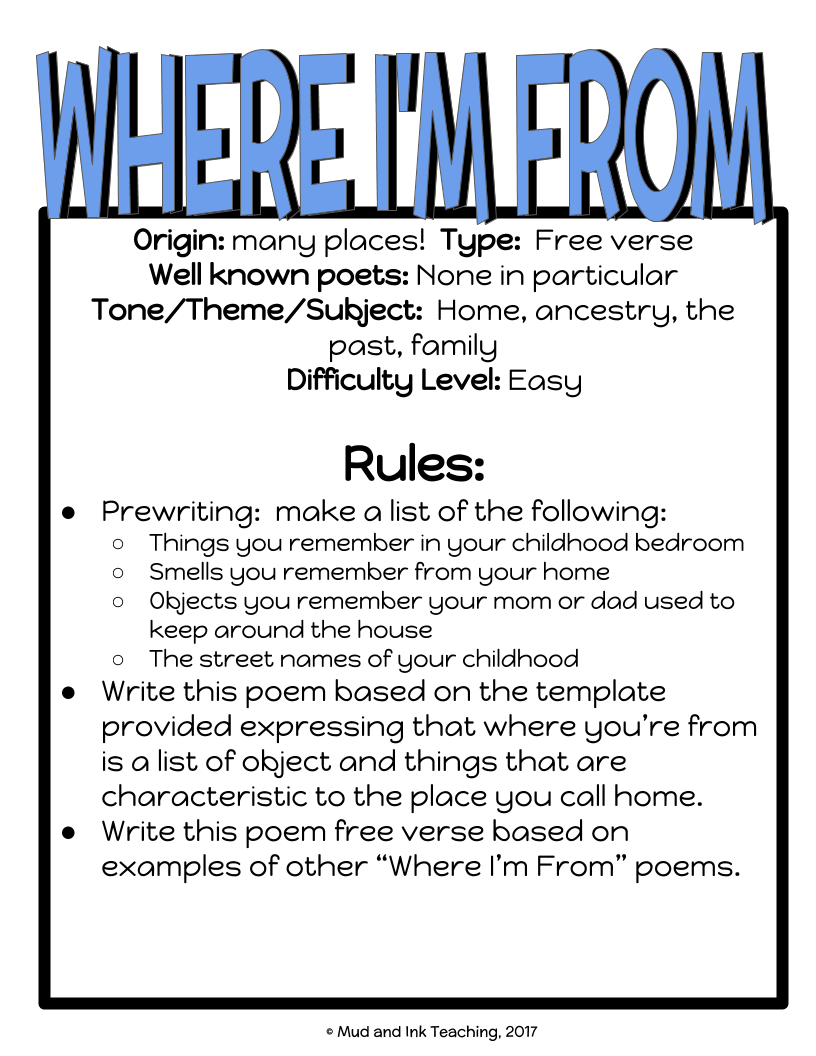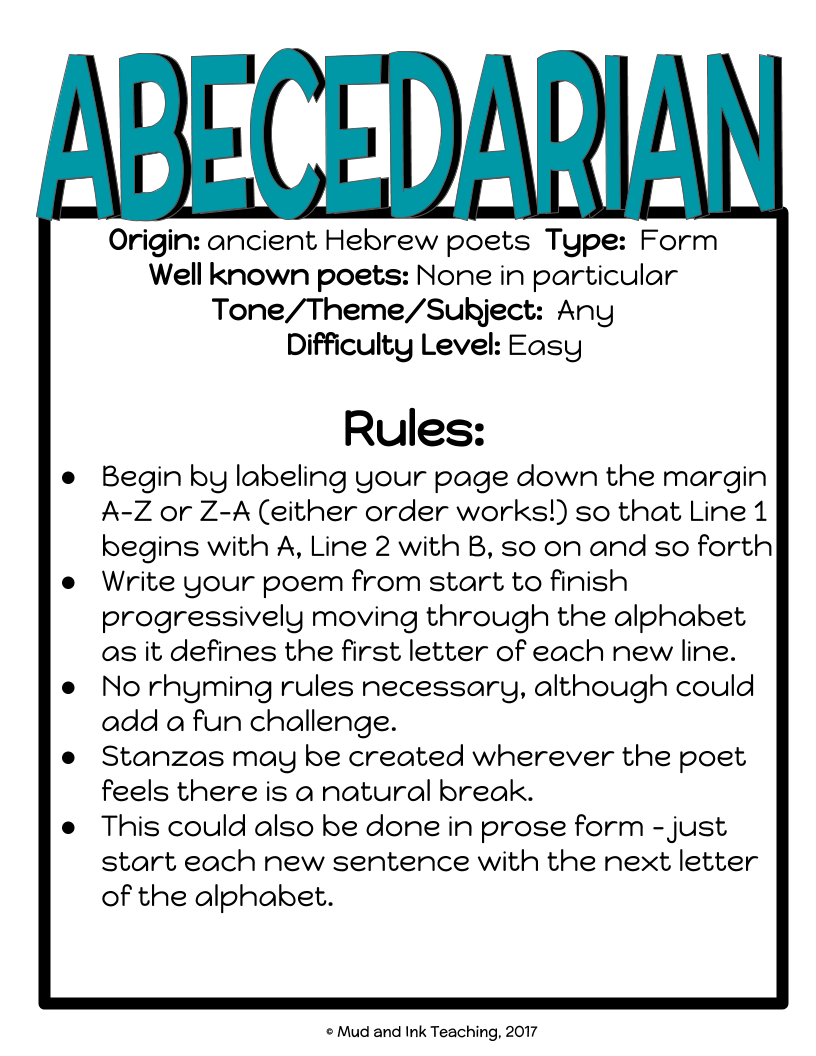
ADVENTUROUS TEACHING STARTS HERE.
Teaching Annotation with Google Keep
Over a decade of teaching, I feel like I’ve heard it all! This year, however, I feel like I’ve found a new and sustainable way of reframing how I look at annotation. Yes, it does involve some tech, but don’t be intimidated! It’s a low-tech approach and works on multiple devices.
Teaching annotation to high school students is an ongoing struggle for so many teachers. It’s one of those skills and I find myself continually reinventing ways to teach it and explore it with students. I have faced so many different roadblocks on the path to teaching annotating. Do these scenarios sound familiar?
Students can’t write in their books - they are library copies
I have three classes and only one class set of novels
Students complain about annotating taking too long
Students refuse to mark in their books
Students lose the annotation bookmark I’ve given them to focus their notes
Students “fake” their annotations just to get credit when I “grade” them
Any other good ones? Over a decade of teaching, I feel like I’ve heard it all! This year, however, I feel like I’ve found a new and sustainable way of reframing how I look at annotation. Yes, it does involve some tech, but don’t be intimidated! It’s a low-tech approach and works on multiple devices.
What is Google Keep?
Google Keep is an app I’ve used forever, but only really for personal to-do lists. It’s a sticky-note type of app that allows you to create notes, color code them, check off items on a list, and even share notes with others. Google Keep is connected to all of your other Google products (slides, drive, docs, etc.), so all it requires for your students is a Google login.
Getting Started with Annotation Focal Points
This may seem obvious, but when it comes to annotating, students should have a direct, clear purpose for doing so. Yes, it’s nice to have students mark “C” when they notice a characterization trait, but is that what you’re assessing at the end? For example, when my students are annotating in To Kill a Mockingbird, it’s for major topics (for which they will later create theme statements). On their annotation guide/handout, I tell them to focus on: coming of age, prejudice, empathy, gender roles, and symbolism. That’s it. Those are their Annotation Focal Points.
Using Google Keep to Track Annotations
Now that students have their Annotation Focal Points, they will create as many Google Keep notes as you have focal points (if you have four focal points, they’ll have four Keep notes).
Send students to keep.google.com
Make sure students are logged into their student Google accounts
On the left hand side of the screen, have students click EDIT LABELS. There, they will create a new label titled with whatever book you are studying.
Click on that new label so that it is highlighted on the left hand side of the screen. You are now creating notes under that label, so they will be nicely sorted when students need to access them later.
Where it says “Take a note”, have students copy and paste (or type) their first Annotation Focal Point into the note. The Title can just be a one-word topic and then the note can be the longer version of the focal point that you gave them.
Have students repeat this step for each focal point.
Now, their notes are ready! Every time they read or every few lessons, students can stop here to add to their notes.
Personally, I like to encourage students to annotate for general items in their books as well as these focal points. I tell the students that we are using Google Keep as a highlight reel of the BEST pieces of evidence that match up with our focal points. Good annotating means consistent interaction with the text, so I want them to practice that as well, but as we discussed earlier, sometimes, that’s just a pipe dream. Google Keep is a great alternative that offers an organized, focused approach to monitoring important concepts while reading, but it’s not the perfect solution, either.
Assessing Student Annotations
Since each student is keeping track of their own annotations, there are a few ways you could collect or assess the annotation on Google Keep.
Create an assignment on Google Classroom. Have your students:
Take a screenshot of their Keep notes and submit that image.
Copy and paste the notes they have for one of the categories that YOU select
Give students question that requires they use their notes from Keep - no books allowed!
There are lots of other ways you could assess their annotations, but these are a few that I’ve tried and liked so far. My favorite part? I will NEVER collect books to check-in annotation ever again!!
How else have you used Google Keep in the classroom? Share your strategies with us below in the comments! I’m actively using this while teaching my Great Gatsby and To Kill a Mockingbird units and loving it so far!
Don’t forget - if you love trying new ideas and getting inspired by others who are adventurous just like you, join our Adventurous Teaching Academy on Facebook!
SHOP THE MUD AND INK STORE:
Slam Poetry 101: An Introduction
I can't think of a more authentic experience that I've had teaching poetry with my students than through the incredible power of slam poetry. Here in Chicago, we're lucky. The slam poetry scene is strong. We're actually the city that gave birth to the slam poetry movement in the 80s...
I can't think of a more authentic experience that I've had teaching poetry with my students than through the incredible power of slam poetry.
Here in Chicago, we're lucky. The slam poetry scene is strong. We're actually the city that gave birth to the slam poetry movement in the 80s. Blue collar, steel worker Marc Smith decided that he was sick of the elitist stigma attached to poetry and he was determined to change that. With a drink in one hand and a poem in the other, Marc Smith took the stage at the Green Mill Lounge (formerly one of Al Capone's secret hideouts), and began building the slam poetry movement.
From there, Chicago continued to grow on the poetry scene as the famed Louder Than a Bomb was created for the youth in Chicago as a way to patch together a massively segregated city. Louder Than a Bomb is the world's largest teen poetry competition and cities all over the world are starting to create their own Louder Than a Bomb tournaments. We had the incredible opportunity to bring teams several years in a row to competition: we took kids from mixed backgrounds, all different kinds of stories, wrote poems, practiced and rehearsed them, and finally performed them on a stage in front of total strangers and five judges.
What is Slam Poetry?
Slam poetry is a competitive form of spoken word poetry. Students can perform poetry all they want, but for it to be a SLAM poem, that means that it's ready for battle! The idea of poetry being a "competition" is ludicrous, as admitted by founder Marc Smith. As the saying goes, "the point is not the points, the point is the POETRY". The only reason slam poetry is a competition is to get the audience to fill seats. Before slam, poetry readings were characteristically boring and not really an event anyone was interested in attending. By adding the competition element to poetry, slam helps to build a new, energetic, excited community around poetry. Please remind your students that, essentially, the competition is a complete and total joke.
Who are the judges?
At a "real" slam, the judges should be total random people pulled in from the street or even the audience. The "judges" should be ordinary people who like poetry - not professors or other experts. The judges usually provide a "reason for selection" to the MC and those reasons are usually pretty funny! Before the start of the slam, the MC introduces the judges with lines like, "Alright everyone, it's time to meet the judges. Let's cheer for them now because later, you'll probably be pretty mad at them! Let's meet Leslie - she's qualified for judging a slam because she has a pet bulldog. Let's clap for Leslie!" Once all of the judges are introduce, they will usually judge a primary "sacrificial poet" to calibrate their scoring. Each judge has a whiteboard and is directed to score the poems on a scale of 1-10 with only one decimal place. If you are able to get five judges, you will drop the high and the low score, then total the three remaining scores for each performance.
What are common themes or topics in slam poems?
When I listen to the young people in Chicago speaking their truth on the stage, these poems are filled with passion. They are typically deeply in touch with a social justice issue, namely: equality, gun violence, cultural acceptance, and poverty. Poems are often about family, about how childhood has affected these students, and about their uncertain futures. The poems are optimistically hopeful and painfully despondent. The answer is, there is no common theme or topic, but the poems are deeply personal to each and every poet. And you can FEEL IT. You can feel it coming out of their souls on stage. If your students are searching for a slam poem topic, have them start with where they're from, a story from their lives. If they're faking their passion in the poem, the audience will know right away.
How does one "win" a poetry slam?
At the end of the slam, all of the points have been added up for each poet. The top TWO poets move on to the final round. In this round, the audience chooses a completely random topic by shouting them out to the MC. The MC chooses one of them, let's say "hippos", and then gives the two final poets two minutes to write a new poem on the topic of "hippos". At the end of two minutes, the poets read and the audience decides on their winner based on the almighty applause-o-meter.
How can I host a slam in my classroom?
Let me stop you right there. First, you need to decide what kind of atmosphere you want in your classroom. An OPEN MIC might be a better option for some teachers: at an open mic, all students read their poems aloud to the class, no judges, no scores, no competition.
My recommendation would be starting with an open mic, and then have students vote on the top 10 students they'd like to see compete in a SLAM. Those 10 students would need to have another poem ready to perform, so consider having your students prepare TWO poems: one for open mic and another in case they are selected for the class slam!
Next, pick your slam day, pick your judges, and come up with a fun prize for the winner. Voila!
Need a helping hand? Here's a quick, free, one-pager ready to download and print. Get your students writing slam poetry today!
SHOP THE MUD AND INK STORE:
Teaching the Poetry Mashup
If there is one thing that is constant among generations of teenagers, it is the love of music. And if there’s one thing that English teachers know, it’s that music is the perfect gateway to getting students into poetry. Today, I’d like to share an awesome poetry/music pairing to try in your own classroom: Carl Sandburg's “Chicago” meets Patrick Stump’s “This City is My City”. The Literary Maven has an incredible blog post out about poetry mashups (coming in April!) with lots of suggestions from other ELA teachers, but I wanted to share my mashup here in a bit more detail for you all.
Make sure to read to the end for your FREE LESSON DOWNLOAD!!
If there is one thing that is constant among generations of teenagers, it is the love of music. And if there’s one thing that English teachers know, it’s that music is the perfect gateway to getting students into poetry. Today, I’d like to share an awesome poetry/music pairing to try in your own classroom: Carl Sandburg’s “Chicago” meets Patrick Stump’s “This City is My City”. The Literary Maven has an incredible blog post out about poetry mashups (coming in April!) with lots of suggestions from other ELA teachers, but I wanted to share my mashup here in a bit more detail for you all.
My Glee Mash-up nickname for this lesson is “This City is My City of Broad Shoulders”. Clever, huh? I thought you’d like that. When you teach paired poetry, you’re asking something truly unique and rigorous of them: you’re asking them to consider similarities and differences across genres and often across huge time gaps in history. Asking your students how and why the pieces relate to one another, even just casually, is a beautiful exercise in critical thinking. But you can construct something more purposeful, too! I love the mashup of these two pieces and I’d like to discuss why these two pieces are so cool together.
Stump’s “This City” has lyrics that describe pride in a city despite its flaws and corruption and Sandburg does something very similar in his poem. Stump writes:
“From every high rise
Down to every slum
From every unethical politician to the wise old beat up bum
My city and I our hearts beat, beat, beat together
When I’m home we both breathe, breathe, breathe together
This place is my home, wherever I go, I, I, I, I, I take it with me”
and Sandburg writes:
“And they tell me you are crooked and I answer: yes, it is true I have seen the gunman kill and go free to kill again.
And they tell me you are brutal and my reply is: On the faces of women and children I have seen the marks of wanton hunger.
And having answered so I turn once more to those who sneer at this my city, and I give them back the sneer and say to them:
Come and show me another city with lifted head singing so proud to be alive and coarse and strong and cunning.”
These two voices, so distant in time and genre, have such a scrappy, unapologetic sense of pride for their cities. Both poets use a counter argument structure: they acknowledge the faults of their cities, then come right down and defend their homes. Stump identifies the “unethical politician” while Sandburg references having “seen the gunman kill and go free to kill again”. The reason I enjoy pairing these two together is because Stump’s version is so simple and approachable. His language is plain and the song is catchy, so it makes for a nice scaffold. Once you layer on “Chicago”, the language gets more difficult, but since you’re approaching it in the same context as “This City”, the students already have a frame for the poem.
As you look through these parallels with students (and there are several more!), I would suggest focusing in on four major aspects of the poems: the tone, the message, the speakers, and the figurative language. Depending on your class, you might even narrow that list down to just two things to focus on.
Wouldn’t this be a great opportunity for some close reading practice? I have a few ideas to share with you. Ready?
THREE WAYS TO ENGAGE STUDENTS WITH MASHUPS:
1. The Mashup Poem
Just like this blog post title, this activity asks students to combine the two works together into a unique poem of their own. Have you ever had students write a blackout poem? This concept is similar! Provide both the poem and the song to students printed out. Have students place the two pieces side by side. With a pen, highlighter or sharpie, have students read the poem as if they were blended together across the margins. For example, in the Sandburg/Stump Mashup, the first line would read: “This city is my city/Hog Butcher of the World”. As the students read across the two poems like this, they should use their writing utensil to underline the phrases they like the best and start blending their favorite parts together and eliminating some of the text as they go. By the time they’re done, everyone will have a unique poem even though they all started with the same two sets of text!
2. Compare/Contrast
For this lesson, I give students a regular ole’ venn diagram, but with a twist. This venn diagram is sectioned off into the four elements that we focused on an annotated as we were reading. To use this venn diagram, you could do stations, you could do a jigsaw, or you might even break students up into small groups and have them present what they found. I would suggest doing one of the sections together as a model and then assign the rest for small group work or homework (depending on their skill level). Encourage students to write direct lines (textual evidence) in the venn diagram as much as they can! They should avoid vague statements and summary as they work through the organizer.
3. Deeper Analysis
Once they’ve finished comparing and contrasting, now they can move on to some writing about their observations. For this next level part of the lesson, students will choose one element that they identified and defend how and why this similarity or difference is significant. For example, if the students identified the tone of “This City” as joyful and the tone of “Chicago” as empowered, students would then discuss how that ultimately impacts the message of each poem and makes them different from one another. This is the part of the lesson that higher level students should work on the most and younger, more inexperienced students should practice with you and be encouraged to try. Don’t skip this step -- it’s HARD, but it’s IMPORTANT!
What are some other mashups that you’d like to try? Let me know in the comments!
SHOP RESOURCES
Six Ways to Create Warmth in your December Classroom (and still take care of business!)
There’s a lot more to teaching in the month of December than just cute holiday sentiments. This time of year is challenging for so many reasons; from the looming horror of final exams to the downright awful cold weather (remember, Chicago girl here!), December is a teaching challenge of focus, measuring learning from the entire semester, and finding ways to authentically remember the heart of the season in our classrooms.
This month, I've taken on the challenge to be part of the 12 Days of December Blog Hop and Giveaway! I teamed up with some incredible secondary teachers to write about "comfort and joy" during the holiday season in our classrooms.
When I think of “comfort and joy” in my classroom around December, what I look forward to most is getting my YouTube fireplace crackling on the screen at the front of my room!
This one comes with Christmas music:
And this one just crackles:
But as we all know, there’s a lot more to teaching in the month of December than just cute holiday sentiments. This time of year is challenging for so many reasons; from the looming horror of final exams to the downright awful cold weather (remember, Chicago girl here!), December is a teaching challenge of focus, measuring learning from the entire semester, and finding ways to authentically remember the heart of the season in our classrooms.
Here are SIX ways I tackle the challenges of this tricky teaching month (and keep things warm and cozy, too!):
1: Plan a White Elephant Holiday Party!
If you’re like me, you’ve been saying “no” to class parties all semester. This is the one time of year that I give in! We usually have an awkward calendar day right at the end of the semester, and so I seize this opportunity to let the kids have a party. And not just a sit around, eat, and stare at each other party...a White Elephant Party! By having a specific kind of gift exchange, it keeps the class moderately sane (students have to pay attention in order to play the game!) and keeps any socially awkward classes from getting too...socially awkward!
2: Fun, but meaningful, end of semester review for finals
You’ve covered so much material since August, and finals are right around the corner. As much as we’d like to just wrap things up and be done, students are going to be anxious about their final grades and getting prepared for their exams. In the English classroom, there are TONS of fun, warm, and joyful ways to do this! Consider:
Create Character Stockings: In this easy “craftivity”, students choose a character of significance from the semester and design a stocking that fully represents him or her. The stocking should include both textual evidence and symbolic imagery that encapsulates that character’s most important contributions to the work of literature. Have students give brief “presentations” of the stocking before you hang them up by the fireplace in your classroom. This will serve as both a review of important character moments and a speaking and listening grade before the end of the term!
Try a new techy review game that you haven’t had time to play this semester. Platforms like Kahoot!, Quizziz, and Quizlet Live are easy to use and energy boosters during the winter blues.
3: Thematic, argumentative writing
Some of you might not have finals until after winter break. This means that you have to fill all of December with meaningful, rigorous work to keep your kiddos from going bananas. Why not try out this mini-unit in argumentative writing? Pose the question: do the holidays make people more generous or greedy? Then, using the lesson plan, send students off to search through ten different articles and videos looking for evidence to support each side of the argument. After a few days of reading and notetaking, challenge the students to write an essay taking a side embedding and using the evidence they’ve found from the provided nonfiction resources. This could easily take you anywhere from two to six class periods and is sure to keep them both academically focused but also enjoying some humor and seasonally related discussions.
4: A Decor Update
This is a great time of year to warm up your room with a few simple decor ideas. Have you seen some of these before?
I LOVE these Winter Literary Device Posters from Ashley Bible of B’s Book Love. I have her nature-themed ones and love those too! These are the perfect wintery touch for any ELA teacher’s classroom.
Turn your classroom library full of books into a tree!
Make a classroom fireplace! Check out this tutorial from Little Running Teacher in the Philippines. It brightens and warms her classroom right up!
5: Service Learning Project and/or Field Trip
If you have some time to spare and need to fill it with something meaningful, this is a great time of year to start a service learning project or take a service learning field trip! I have a great way to get started on a project with Be the Change! Thinking about a field trip instead? How about taking your crew to Feed My Starving Children? This organization is perfectly set up for school trips, they spend time educating students about what they’re doing and why, and they make the volunteering time a blast!
6: Random Acts of Kindness Challenge
To really get into the spirit of joy and giving, why not challenge your students to complete this Random Acts of Kindness Challenge? Have students work together as a class and use a class hashtag to share photos on Twitter or Instagram completing each challenge. Take all of those pictures and throw them into an Animoto video to show at your White Elephant party! This free download is editable and ready for you completely customize for your own students and school.
Don't forget to check out all of the other amazing secondary bloggers sharing their ideas for creating comfort and joy in your classroom all winter long and be SURE that you enter our amazing giveaway! We are raffling off gift cards on December 1st, 4th, 8th, and 12th, so be sure to enter early and often to get your shot at some seriously crazy prizes!
Can your class write 30 poems in 30 days?
If you love poetry, and you're a little bit competitive (like me!) then I have just the challenge for you! How about jumping on the #30poems30days Challenge!
This year in creative writing, I've decided that I want my students to have access to as many different styles of poetry as possible. That's why I've narrowed down my 30 favorite types of poems to teach - and I'm going to teach them all in just 30 days!
If you love poetry, and you're a little bit competitive (like me!) then I have just the challenge for you! How about jumping on the #30poems30days Challenge!
This year in creative writing, I've decided that I want my students to have access to as many different styles of poetry as possible. That's why I've narrowed down my 30 favorite types of poems to teach - and I'm going to teach them all in just 30 days! It's going to be crazy, and I won't be able to get into great depth with each poetic form or style, but what I will be able to do is expose my students to a huge variety of poems so that they can decide for themselves what kind of poets they want to be. Here's everything you need to know about Write 30 Poems in 30 Days...
Poem Types
I've broken down my selection into three major categories: form poetry, free verse poetry, and found poetry. Form poetry consists of the kinds of poems that require adherence to a very strict rhyme scheme or syllable pattern. Free verse poetry is just that - free to the stylistic discretion of each poet! I've provided a few themes and topics and "kinds" of poems to help jumpstart student writing. Finally, found poetry is the type of poetry that is a gathering of language in the world around the poet, then composed and arranged in a brand new, unique way! Click through some examples below...
Setting Up the Challenge
In my classroom, I've laminated 30 pieces of scrapbook cardstock and numbered them 1-30. I then printed off my Write 30 Poems in 30 Days handouts, and one by one, I'll be posting those up on the wall in the order that I teach each poem (see image gallery for an idea!). Next, I will be assigning students their digital poetry interactive notebooks (included with the product!) and each day they write, they will add to their notebooks. Everything is neatly organized through Google Classroom, so no crazy notebook lugging back and forth from home for me!!
Are You READY for the CHALLENGE?
I sure hope so! Follow along using #30poems30days and catch my students on Instagram @mudandinkteaching.
I want to do poetry in April, but this sounds too intense for me...
Never fear! I have a really simple Poetry Teacher's Ultimate Survival Guide handbook for teachers just like you! Grab your free copy right now!
SHOP THE MUD & INK STORE
The YouTube Scavenger Hunt
Right about now, everyone's turned to the "leggings only" mentality: not only have we decided to stop putting together Instagram-worthy outfits and Pinterest-perfect lessons and procedures, but we're starting to cut corners and cover them all up with a nice, flowy dress.
Right about now, everyone's turned to the "leggings only" mentality: not only have we decided to stop putting together Instagram-worthy outfits and Pinterest-perfect lessons and procedures, but we're starting to cut corners and cover them all up with a nice, flowy dress. This is teaching in the doldrums of winter.
Have you reached the elastic-waistband version of yourself as a teacher? If so, I'm with you. All. the. WAY! For these last few days before break, I want to do right by my kids, teach great content, but the above and beyond-ness of my normal school gig will just have to wait until after the holidays.
This post, however, will not get you to the break. You're on your own. What I'm here today to give you is your POST break solution. Once you've made it to break, relaxed on your break, there's something else that you still need to do: GO BACK TO SCHOOL AGAIN! And as exciting as it is to start fresh in the new year, it can be a bit of an adjustment getting back into the swing of things. So, from my classroom to yours, here is the only lesson you need to get you through the first one to three class periods when you return from break.
The YouTube Scavenger Hunt
1. Decide on content and topic
Are you in the midst of a novel unit right now? Starting? Finishing? Are you working on a research project? Would you like to introduce your students to poetry? Once you've chosen your topic, read on!
2. Choose your outcome
What do you want your students to be able to do by the end of the scavenger hunt? To answer a synthesis question? To present their findings? To discuss their revelations Socratic seminar style?
3. Create your handout
Keep it simple or just use mine and modify to your liking. The handout should be a simple, open guide for students to take notes as they scour through your YouTube playlist. Ask a few pointed, but strategically open-ended questions and leave room for ideas, scribbles, notes, textual evidence, etc. You might include (at the end) the finished product or activity they will do or participate in the following day so that students are prepared.
4. Create your YouTube Playlist
Here is the beautiful part. No matter your topic or current unit of study, there are hundreds of connected and relevant YouTube videos that will help students understand your objectives more clearly. For example, when my students are in their Slam Poetry unit, guess what kinds of videos I stash on the YouTube playlist? My (and student's) absolute favorite slam poems. Reading a novel with some complicated history? Add it to the playlist. Exploring a controversial issue? Add videos from both sides of the argument to the playlist (and a few in between!) Working on rhetorical analysis? Get some commercials ready to go!
A YouTube Playlist Scavenger Hunt might sound like a cop-out, but consider these delightful details:
It's completely student-centered
It offers student choice
The questions can be scaffolded for an appropriate amount of rigor
The activity expands background knowledge
Students are actually working on LISTENING skills
Students are hardly distracted on YouTube when their assignment is to watch YouTube.
Here's one of my favorite playlists to use for this kind of activity: it's a Social Justice Poetry Slam playlist! Feel free to take it and use it with the handout attached above.

